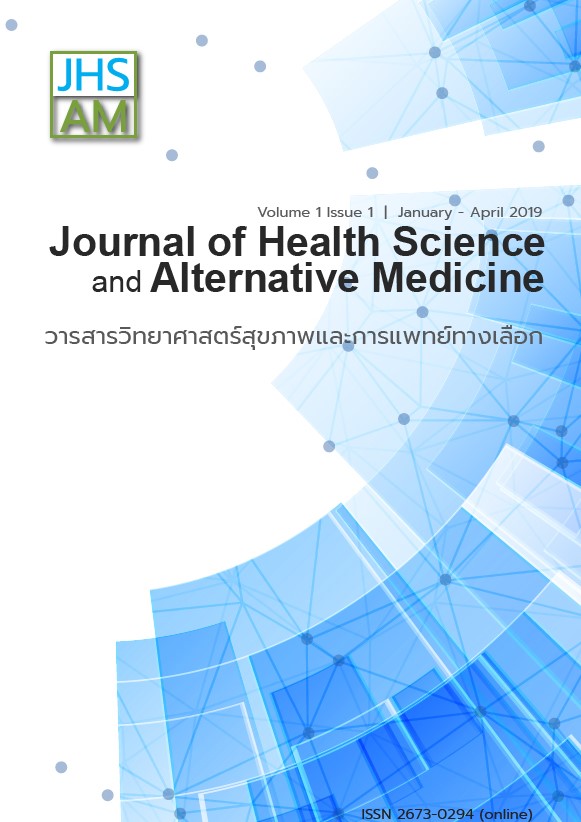Adaptation to Thai Citizenship: A Case Study of Thai-Chinese Yunnan, Mae Fah Laung District, Chiang Rai, Thailand -
Main Article Content
Abstract
Introduction: Chinese Yunnan migrated into Thailand through Myanmar for different reasons, and have settled in mountainous areas in northern Thailand especially Mae Fah Luang District, Chiang Rai Province, Thailand. Objective: The study aimed to understand the development and adaptation to the new environment and obtaining Thai citizenship among the Chinese Yunnan. Methods: A validated question guideline was used for gathering the information and an in-depth interview was done with 24 key informants including male and female of different age categories. Results: We found that after passing through the 3rd generation, Chinese Yunnan have become Thai-Chinese Yunnan completely, integrated aspects of Thai culture, education, politics, trade and enjoy the same rights as Thai people. Currently, they feel themselves Thai and pound of to be Thai. However, most of Thai-Chinese Yunnan still maintain some Chinese identity through local language, local food, traditional and cultural patterns. Conclusion: After passing for years, the Thai-Chinese Yunnan are completely become Thai but still maintain their cultures and some life styles.
Article Details
JHSAM publishes all articles in full open access, meaning unlimited use and reuse of articles with appropriate credit to the authors.
All our articles are published under a Creative Commons "CC-BY-NC-ND 4.0". License which permits use, distribution and reproduction in any medium,
provided that the original work is properly cited and is used for noncommercial purposes.
References
[2] Semmanee A. Chinese Muslim in Chiang Mai province of Thailand. Princess of Naradhiwas University. Journal of Humanities and Social Science 2015; 2(2): 39–49.
[3] Sueanhan T, Patin O. Dynamic of Haw’s vernacular architecture: case study at Santi Chon, Pai District, Mae Hong Son; 2015. [Cited 2019 Febraury 13]. Available from: https://www.thapra.lib.su.ac.th/thesis/showthesis_th.asp?id=0000010952
[4] Chiang Rai Cultural Office. Chiang Rai variety of ethnic charm; 2016. [Cited 2018 December 16]. Available from: https://www.mculture.go.th/backendeasyot8jt/ewt/chiangrai/article_attach/article_ fileattach20161103104
[5] Ministry of Social Department and Human Security. Ethnicity in Thailand; 2014. [Cited 2018 December 16]. Available from: https://www.chatipan.dsdw.go.th/pdf/F001.pdf
[6] Charoenwong K. An investigation on Chinese migrants in the northern region border of Thailand: socio-economic and political changes; 1990. [Cited 2017August 7]. Available from https://www.sac.or.th/databases/ethnicredb/research_detail.php?id=267
[7] Sinchaiworawong K. A comparative study of settlement and architecture of Akha ethnic group, between Luang Nam Tha, Laos and Chiang Rai, Thailand; 2003. [Cited 2017 August 7]. Available from: https://www.sac.or.th/databases/ethnicredb/research_detail.php?id=319
[8] Pourret JG. The Yao: The Mien and Mun Yao in China, Vietnam, Laos and Thailand: translated by Mongkon Chanbamrung & Somkiat Jamlong; 2002. [Cited 2017August 7]. Available from https://www.sac.or.th/databases/ethnicredb/research_detail.php?id=721
[9] Rukspollmuang C. The Education of Shan, Yunnanese, Lua and Karen: a case study in Ban Mai Loong Khon, Ban Tham, Ban Kong Loi, and Ban Pa Taek; 1988. [Cited 2017 August 7]. Available from: https://www.sac.or.th/databases/ethnicredb/research_detail.php?id=100
[10] Phatthanakaya P. A study of Lahu Babtist church history in Thailand; 1991. [Cited 2018 November 27] Available from: https://www.sac.or.th/databases/ethnicredb/research_detail.php?id=362
[11] Boonyasaranai P, Choemui M. Akha social life and customs in northern Thailand; 2014. [Cited 2018 November 27]. Available from: https://www.sac.or.th/databases/ethnicredb/research_detail.php?id=755
[12] Rithnatikul L. The Hmong’s adaptation to the urban communities: a case study at muang Chiang Mai district; 1997. [Cited 2018 November 27]. Availabe from: https://research.culture.go.th/index.php/research/nt/item/226-2012-09-16-00-02-08.html
[13] Wacharakiattisak W. Problems of Chinese Yunnanese immigrants under the supervision of the Ministry of Interior : a case study of Mae Sai district, Chiang Rai province; 1996. [Cited 2018 November 27]. Availabe from: https://www.sac.or.th/databases/ethnicredb/research_detail.php?id=1053
[14] Chua-Maharwan S. Color terms and color perception of Tailue, Lua, Mong and Karen Speakers in Chiang Rai and Pha Yao; 1998. [Cited 2018 November 23]. Available from: https://www.sac.or.th/databases/ethnicredb/research_detail.php?id=40
[15] Boonkamyeang S. The contested meanings of the forest and the conflicting claims over the space: a case study of the Lahu tribe; 1997. [Cited 2018 December 13]. Availabe from: https://www.sac.or.th/databases/ethnicredb/research_detail.php?id=252
[16] Inter Mountain Peoples’ Education and Culture in Thailand Association (IMPECT). Indigenous knowledge of Mien (Yao); 2002. [Cited 2019 January 21]. Available from: https://www.sac.or.th/databases/ethnicredb/research_detail.php?id=551
[17] Donavanik B. A study of Thai -South China boarder trade situation of Thai upper northern 10 lines of handicraft; 2016 . [Cited 2019 January 21] Available from: https://cmruir.cmru.ac.th/handle/123456789/404
[18] Manohan P. Uneven development between state and borderland: a case study of Chiang Khong district, Chiang Rai province, 3(1), 66–93. [Cited 2019 January 21]. Available from: https://www.human.lpru.ac.th/husocojs/index.php/HUSOCReview/article/viewFile/25/25
[19] Ministry of Interior. (2018). Act of Thai citizenship, no.1965. [Cited 2019 March 24]. Available from: https://www.bora.dopa.go.th/nationclinic/NewHTML/Section10.htm
[20] Apidechkul T, Laingoen O, Suwannaporn S. Inequity in accessing health care service in Thailand in 2015: a case study of the hill tribe people in Mae Fah Luang district, Chiang Rai, Thailand. J Health Res 2016; 30(1): 67-71. DOI: 10.14456/jhr.2016.10
[21] Apidechkul T. A 20-year retrospective cohort study of TB infection amongthe hill tribe HIV/AIDS populations, Thailand. BMC Infect Dis 2016; 16: 72. DOI: 10.1186/s12879-016-1407-4.
[22] Apidechkul T. Epidemiology of the hill tribe HIV/AIDS populations, Thailand. J Med Assoc Thai 2016; 99(6): 702-11.
[23] Apidechkul T. Prevalence and factors associated with type 2 diabetes mellitus and hypertension among the hill tribe elderly populations in northern Thailand. BMC Public Health 208; 18: 694. DOI: 10.1186/s12889-018-5607-2.

